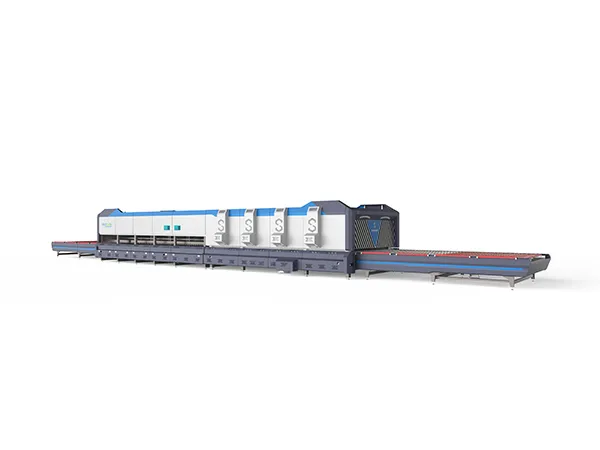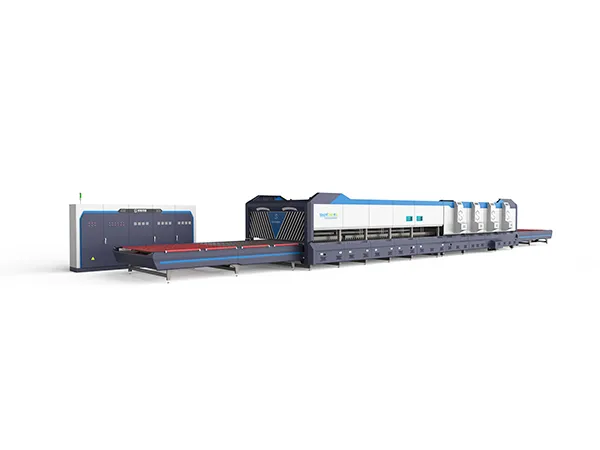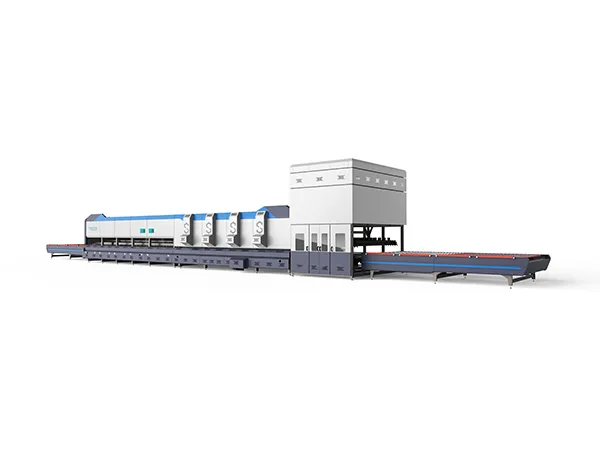Optimizing glass product quality through a glass tempering furnace requires precise control over multiple factors, including temperature, heating time, cooling rate, and glass handling.Optimizing glass product quality through a glass tempering furnace is a complex process that involves careful control and monitoring of several factors.
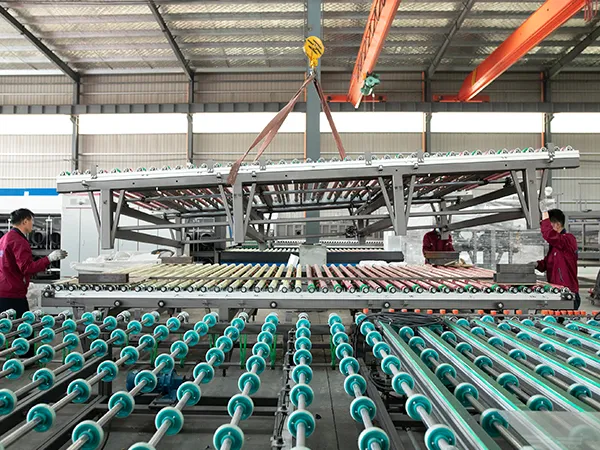
1. Pre-Tempering Processes (Before the Furnace):
Glass Selection & Quality:
Raw Material Quality: Start with high-quality glass sheets free of inclusions, bubbles, or surface defects.
Glass Thickness & Type: Ensure the glass type (e.g., float glass, low-E glass) is suitable for tempering and that the thickness is within the furnace's capabilities. Incorrect thickness can lead to uneven heating and tempering.
Cleanliness: Thoroughly clean the glass before it enters the furnace. Contaminants like dust, oil, or fingerprints can cause uneven heating, spotting, or adhesion issues. Use appropriate glass cleaners and deionized water for rinsing.
Cutting & Edge Work:
Accurate Cutting: Precise cutting is crucial for uniform heating and stress distribution. Use automated cutting tables and laser alignment systems for optimal accuracy.
Edge Processing: Smooth, polished, and defect-free edges are critical. Chips, cracks, or sharp edges can act as stress concentrators, leading to breakage during or after tempering. Use grinding, polishing, or seaming machines to achieve high-quality edges.
Hole Drilling/Notching (if applicable): Carefully drill or notch holes before tempering. Sharp corners or imperfections around holes are significant stress points. Use CNC machining with precise settings.
Low-E Coating Consideration:
Coating Compatibility: Ensure the low-E coating is compatible with the tempering process. Some coatings may require specific temperature profiles or protective measures.
Coating Placement: Correctly orient the glass in the furnace, as the low-E coating usually needs to face a particular direction for optimal heating.
Coating Protection: In some cases, protective coatings may be applied to the low-E surface to prevent damage during the tempering process.
2. Tempering Furnace Operation & Control:
Temperature Control:
Zoning: Modern furnaces have multiple heating zones (top, bottom, and sometimes sides). Precise temperature control in each zone is essential for uniform heating. Use accurate thermocouples and control systems.
Temperature Profiling: Establish and maintain a precise temperature profile for each glass type and thickness. This involves gradually increasing the temperature to the desired level (typically above the glass transition temperature), holding it for a specific soak time, and then rapidly cooling.
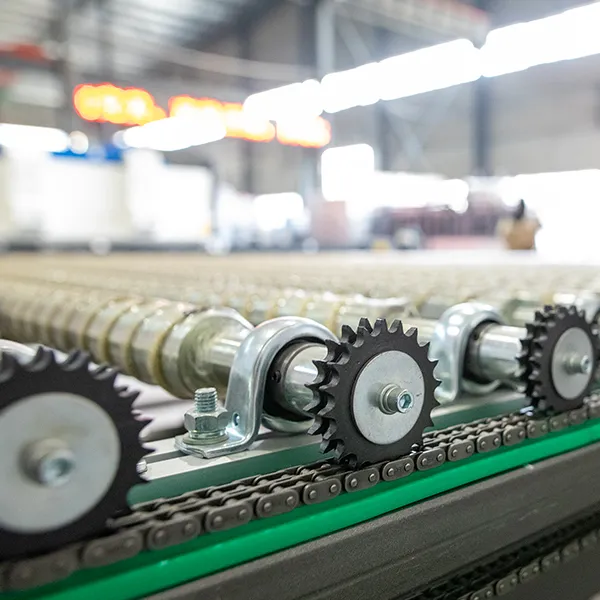
Temperature Monitoring & Adjustment: Continuously monitor temperatures throughout the furnace and adjust as needed to compensate for variations in glass load, ambient temperature, or furnace performance. Use data logging and analysis to identify and correct deviations.
Heating Method & Efficiency:
Radiant Heating: Most tempering furnaces use radiant heaters (electric or gas-fired). Ensure the heaters are clean, properly maintained, and uniformly distributing heat.
Convection Assistance (optional): Some furnaces incorporate convection blowers to improve heat transfer and temperature uniformity. Check the blowers for proper operation and airflow.
Furnace Calibration: Regularly calibrate the furnace to ensure accurate temperature readings and consistent performance.
Quenching Process:
Air Quenching: Rapidly cool the heated glass using high-pressure air. The cooling rate is critical for achieving the desired stress profile.
Quench Pressure Control: Precisely control the air pressure during quenching. Variations in pressure can lead to uneven tempering.
Quench Nozzle Design & Maintenance: Maintain the quench nozzles to ensure uniform airflow across the glass surface. Clean or replace nozzles as needed to prevent blockages or uneven distribution.
Quench Time: Optimize the quench time to achieve the desired surface compression and core tension. Over-quenching can lead to excessive stress and potential breakage; under-quenching results in insufficient tempering.
Furnace Maintenance:
Regular Inspections: Conduct regular inspections of the furnace, including the heating elements, thermocouples, quench system, and control panels.
Cleaning: Keep the furnace clean to prevent dust and debris from affecting heat transfer and air flow.
Calibration: Calibrate the temperature sensors regularly to ensure accurate temperature readings.
Preventive Maintenance: Follow a preventive maintenance schedule to identify and address potential problems before they lead to downtime or quality issues.
3. Post-Tempering Processes & Quality Control:
Stress Measurement:
Surface Stress Meter (Polariscope): Use a surface stress meter (polarimeter) to measure the surface compression of the tempered glass. This is a critical measurement to verify that the glass meets the required tempering standards.
Edge Stress Measurement: Check edge stress, especially if edge damage is a concern.
Fragmentation Testing (Destructive):
Standard Fragmentation Test: Perform periodic fragmentation tests according to industry standards (e.g., EN 12150, ASTM C1048). This involves breaking a tempered glass sample and examining the resulting fragmentation pattern. The pattern should consist of small, relatively harmless fragments.
Visual Inspection:
Overall Appearance: Visually inspect the tempered glass for any defects such as distortion, waves, scratches, or inclusions.
Edge Quality: Carefully examine the edges for chips, cracks, or other imperfections.
Bow and Warp Measurement:
Flatness Testing: Measure the bow and warp of the tempered glass to ensure it meets specified flatness tolerances. Excessive bow or warp can cause problems during installation or in service.
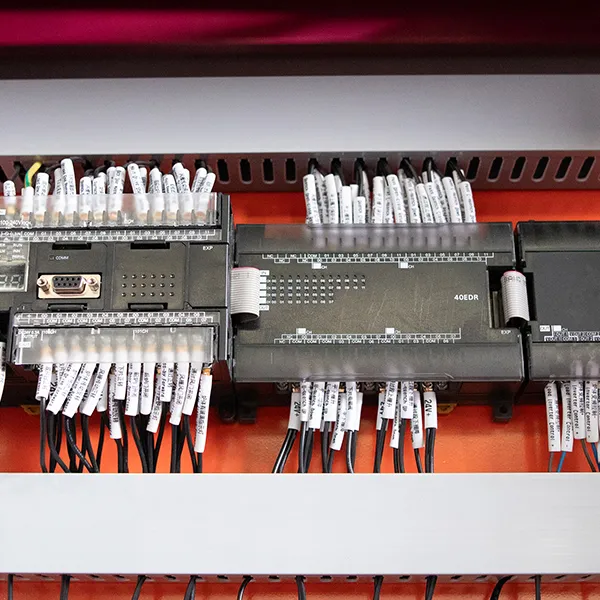
Data Analysis and Process Improvement:
Collect and Analyze Data: Collect data from all stages of the tempering process, including temperature readings, quench pressures, stress measurements, and visual inspection results.
Identify Trends and Patterns: Analyze the data to identify trends and patterns that may indicate potential problems or areas for improvement.
Implement Corrective Actions: Implement corrective actions to address any identified issues and continuously improve the tempering process.
Statistical Process Control (SPC): Implement SPC techniques to monitor and control key process variables and minimize variations.
Key Considerations and Best Practices:
Operator Training: Provide thorough training for furnace operators on all aspects of the tempering process, including furnace operation, temperature control, quenching, quality control, and troubleshooting.
Documentation: Maintain detailed records of all tempering runs, including glass type, thickness, temperature profiles, quench parameters, and quality control results.
Industry Standards: Adhere to relevant industry standards for glass tempering, such as EN 12150 (Europe) or ASTM C1048 (North America).
Continuous Improvement: Implement a continuous improvement program to identify and address areas for improvement in the tempering process.
Communication: Foster open communication between all stakeholders, including operators, engineers, quality control personnel, and management.
By implementing these strategies, you can significantly optimize glass product quality through the glass tempering furnace, reduce scrap rates, improve customer satisfaction, and ensure compliance with industry standards. Remember that consistent monitoring, data analysis, and proactive maintenance are essential for achieving and maintaining optimal results.








